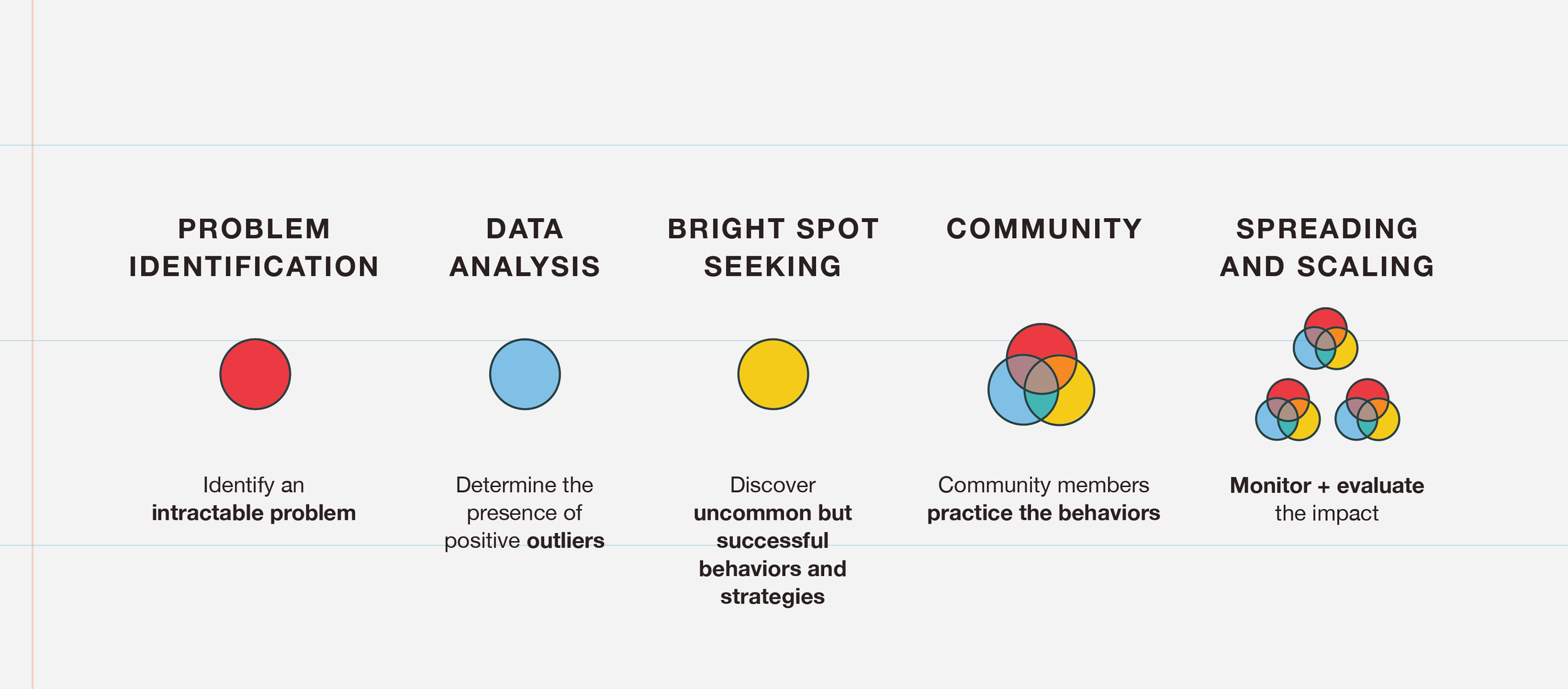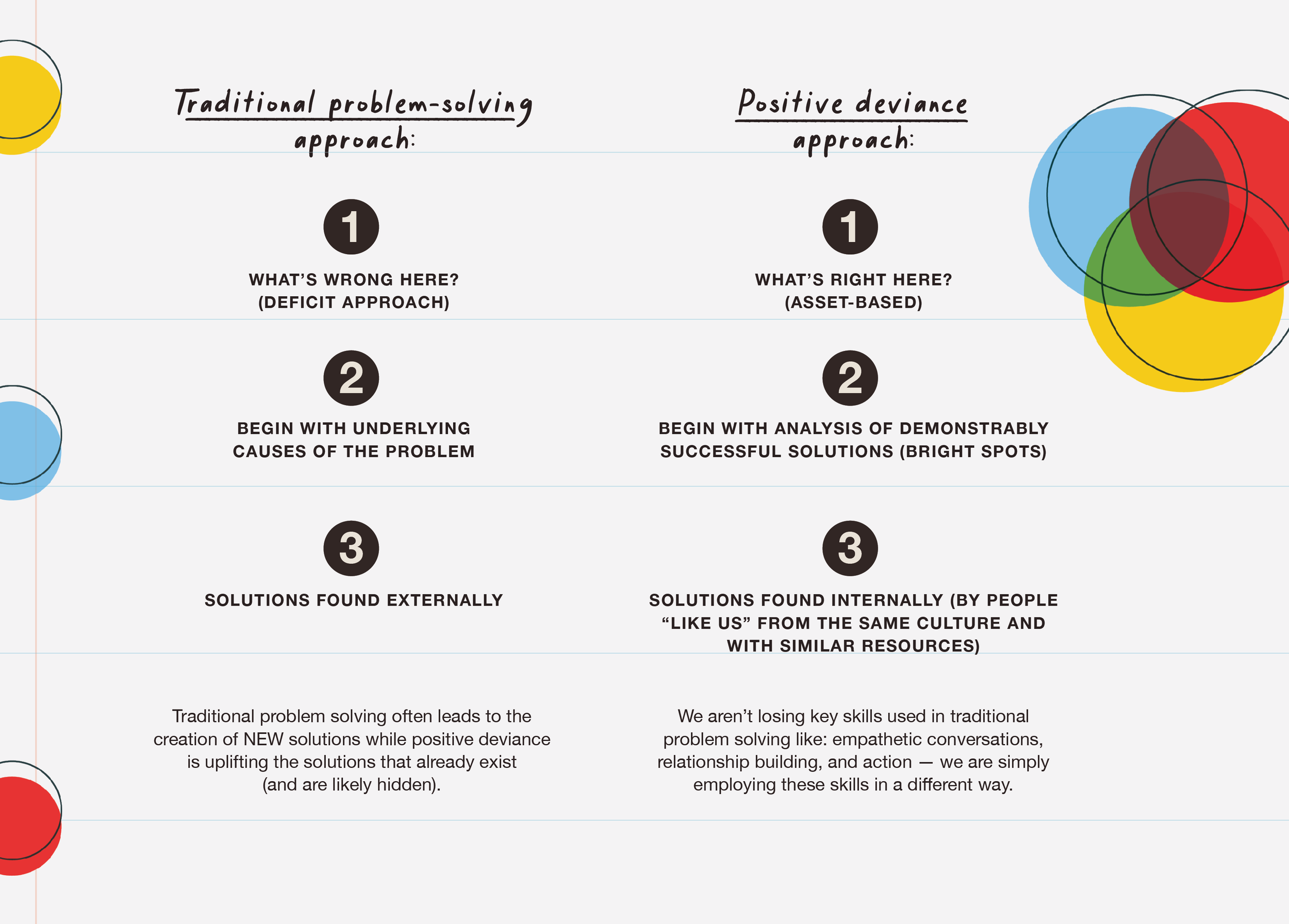Using the Brilliance of our Communities to Find Existing Solutions to Persistent Problems
“Positive deviance is founded on the premise that at least one person in a community, working with the same resources as everyone else, has already licked the problems that confounds others. This individual is an outlier in the statistical sense – an exception, someone whose outcome deviates in a positive way from the norm. In most cases this person does not know [they are] doing anything unusual. Yet once the unique solution is discovered and understood, it can be adopted by the wider community and transform many lives.”
What happens when you move from “how might we?” to “how are we?”
From “what’s wrong here?” to “what’s right here, already?”
Positive deviance (PD) is a practice based on the belief that there is a bright spot within your community that has already found a solution for a sticky, intractable problem you are facing. Over the past two years, the K12 Lab has been exploring the potential for positive deviance in K-12 education. We have engaged over 100 educators from around the globe, working with schools that each represent the complexity, diversity, and opportunity we see across the education sector.
We offer a detailed overview of the history of positive deviance here, and are grateful for the work of Marian Zeitlin and her colleagues at Tufts University Friedman School of Nutrition Science and Policy for their foundational work, and for Richard Pascale, Monique Sternin, and Jerry Sternin for their 2010 book The Power of Positive Deviance: How Unlikely Innovators Solve the World’s Toughest Problems, which inspired our team in this project.
This is the positive deviance process:
Positive Deviance by Design
Resources for Educators
The K12 Lab’s Positive Deviance Toolkit for Educators brings together a suite of tools designed to help school teams identify and solve intractable problems by discovering and scaling their own existing local solutions.
This work is informed by what we learned through working with educators in applying positive deviance tools in their classes. These educators provided insight and feedback on the tools, process, and relevance in their community. We are so grateful for the support they provided, and are excited to share this toolkit as a reflection of their thoughtful work integrating positive deviance in their communities.
Here’s how the toolkit was created
After teaching a d.school class for university students and short-cycle testing some of the positive deviance tools in isolation, the K12 Lab brought the tools together to test them in sequence, as part of a complete tool kit. We put out a call to the community of educators who have engaged with the Lab. We offered educators to come together in school teams to test a new set of prototypes in the service of trying to solve an intractable problem in one of four areas:
Belonging : Our school needs to develop ways to ensure our students are safe and feel a sense of belonging.
Assessment : Our school needs a way to enable our educators in using new and existing assessment methods to improve students’ learning and personal growth.
Civic Engagement : Our school needs to develop ways to enable more students to participate (in quality and quantity) in community and civic life.
Culturally Responsive Teaching : Our school needs to better integrate experiences and materials that are culturally diverse and relevant to our students.
Schools applied to address their own problems within one of these areas, and adapted the problem statement to better fit the contexts and needs within their schools. We were not looking for problems with technical solutions (like something a school could purchase or implement), but rather adaptive solutions, which would require most or all of the staff in the school to change their behavior. Also, in some cases, the general solution may already be known (e.g., students are more engaged with there are opportunities for authentic learning), in which case authentic learning might not be the solution, but rather the outlier teacher who figured out how to do this in a school where no one else does is where we hope the school community turns its attention.
Here’s what teams did
Fifteen schools from eleven countries were selected to participate in the prototype testing. This included trying the prototypes in their schools and engaging in weekly group sessions and team check-in calls. Schools included elementary, middle and high schools, as well as public/district, charter schools, and independent schools. School teams included individuals in a variety of roles and responsibilities across the school.
Together, they engaged in a process that took them from identifying a problem, to finding local examples of people solving that problem, to exploring how they might spread and scale those solutions internally.
Bright Spots
Using the positive deviance process, each team was able to identify a problem, uncover bright spots, and then make a plan to scale their bright spots.
The practices were identified by educators in their own contexts, but we believe there may be value in sharing them with educators more broadly as authentic, home-grown solutions to common problems that might be adapted by educators or used for inspiration. Before sharing the practices widely, we worked with a team of advisors to apply three types of filters: researcher, practitioner, and sorting.
Experts in each content strand reviewed the practices to determine at minimum that there was no significant evidence to suggest the practice described in the bright spot is dangerous or might cause harm.
Practitioners then reviewed the bright spots to determine if it would be possible for other practitioners to effectively use and adapt these practices. That is, we hoped that the expert practitioners would flag any practices that would be overly challenging to apply in a range of school settings.
To provide additional information and better understand the nature of the practices, we then coded the bright spots with 8 sorting filters: who each was designed for (targeted universalism); who identified it (student or practitioner); whether the practice made purposeful use of digital technology; ability to be adapted for differentiated instruction; whether an equity lens was apparent to the team; and whether the bright spot was a practice (as opposed to a person or idea).
Questions we are asking
This project was a prototype. Moving forward, we find ourselves asking a number of questions that we hope will be answered as more school teams use the tool kit:
What types of bright spots are easier and harder to find with this tool kit?
How can school teams get more comfortable using data to find bright spots?
What makes a bright spot more or less scalable?
The issues that continue to emerge in education call for urgent, intentional action.
As the ones closest to the problem, we may have relevant solutions that we haven’t taken the time to examine. Educators are humble, and oftentimes don’t always want a spotlight on the incredible work currently being done to impact students.
Positive deviance helps us uncover how significant these practices, behaviors and mindsets can be. It creates a pathway to share, learn, and create fuller educational and social spaces for students (and the rest of us too). We hope these resources will provide your school community with a new way of seeing the bright spots that already exist around you.
Get involved
If you’re interested in learning more about positive deviance, we recommend starting with these two resources:
- The book that inspired this work: The Power of Positive Deviance: How Unlikely Innovators Solve the World’s Toughest Problems by Jerry Sternin, Monique Sternin, and Richard Pascale
- A great resource with case studies, additional tools, and much more context for how PD has worked across a multitude of industries and environments: Positive Deviance Collaborative

